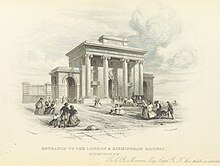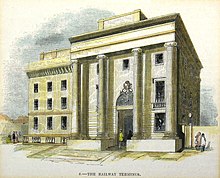Birmingham Curzon Street railway station (1838–1966)
Birmingham Curzon Street | |
|---|---|
| General information | |
| Location | City of Birmingham |
| Coordinates | 52°28′53″N 1°53′07″W / 52.4815°N 1.8853°W |
| History | |
| Original company | London and Birmingham Railway |
| Pre-grouping | London and North Western Railway |
| Post-grouping | London, Midland and Scottish Railway |
| Key dates | |
| 24 June 1838 | Opened as Birmingham |
| November 1852 | Renamed Birmingham Curzon Street |
| 1 July 1854 | Closed to passengers |
| 3 April 1874 | Excursion station opened for passengers |
| 3 April 1893 | Last known use of Excursion station for passengers |
| 1966 | Closed for goods trains |
Birmingham Curzon Street railway station (formerly Birmingham station) was a railway station in central Birmingham, England, opening in 1838 and closed to passengers in 1893 but remaining open for goods until 1966. The station was used by scheduled passenger trains between 1838 and 1854 when it was the terminus for both the London and Birmingham Railway and the Grand Junction Railway, with lines to London, Manchester and Liverpool respectively. Excursion trains ran until 1893 after which only goods trains operated until closure in 1966. More recently, the surviving Grade I listed entrance building was used for occasional art events.
In 2010, a new station, partly on the site of the historical Curzon Street station, was proposed as the Birmingham terminus for High Speed 2. In 2017 plans were approved to redevelop the remaining Grade 1 listed building to turn it into a visitor centre and office space for HS2 and other organisations. HS2 hopes to use the station as the hub for its high-speed line linking London and Birmingham – although these plans are still being developed.[1]
History
The station, originally known as 'Birmingham' station was opened on 24 June 1838, with the first train from London to Birmingham arriving on 17 September. It was the terminus for both the London and Birmingham Railway and the Grand Junction Railway and the companies had adjacent, parallel platforms but there were no through trains.

The Grand Junction Railway arrived at Curzon Street in 1839. Although the line had opened in 1837, one year before the London and Birmingham Railway, it originally ran to a temporary terminus at Vauxhall. A viaduct had to be constructed to allow the line to reach Curzon Street.[2] The smaller Lawley Street station, terminus of the Birmingham and Derby Junction Railway (a forerunner of the Midland Railway) was later opened a short distance to the east.
Behind the main entrance building, the L&B station had a wrought iron framed trainshed which had two spans, and covered an area 217 feet (66 metres) long and 113 feet (34 metres) wide. It had two platforms, one for departures and one for arrivals.[3] The Grand Junction Railway had parallel departure and arrivals platforms and a separate entrance building and booking office (now demolished) further along Curzon Street, designed by Joseph Franklin.[4][5]

Its use as a major passenger station was short lived. It was inconveniently located on the eastern edge of Birmingham city centre, and the station's facilities soon became overwhelmed by the growing traffic. Following the merging of the L&B and Grand Junction railways into the London and North Western Railway (LNWR) in 1846, work started on the new and more conveniently located 'Grand Central' station, which would become known as Birmingham New Street half a mile to the west.[6] shared with the Midland Railway, New Street was completed in 1854. Most passenger services were diverted to the new station the same year.
The name of the station had been changed from 'Birmingham' to 'Birmingham Curzon Street' in November 1852. Part of the overall site (at the corner of New Canal Street and Banbury Street) was modified in 1874 and used from that Easter as an 'excursion station' (to relieve New Street at peak times such as holidays or fair days), used notably by public holiday excursion services to Sutton Coldfield, until Easter 1893 [7] (the 1838 platforms were not so used). The main site continued in use as a goods station until 1966.[8] The platforms, along with the original trainsheds were demolished the same year.[3] The site was then used as a Parcelforce depot until May 2006.[9]
The surviving entrance building

The surviving Grade I listed entrance building was designed by Philip Hardwick as the company’s offices and boardroom.[10] Built in 1838, it is among the world's oldest surviving pieces of monumental railway architecture. Costing £28,000 to build,[11] the architecture is Roman inspired, following Hardwick's trip to Italy in 1818–19. It has tall pillars running up the front of the building, made out of a series of huge blocks of stone. The design mirrored the Euston Arch at the London end of the L&BR. In the original design the building was to be flanked by two arches leading into the station: excavations have revealed that these were never built. The interior was modified in 1839 to accommodate an 'hotel' (the Victoria), although this was probably more in the nature of a refreshment room or public house, and later the booking hall, with a large iron balustraded stone staircase and offices. It is three storeys tall but relatively small. The building was acquired by Birmingham City Council in 1979. A detailed paper from Historic England can be found at the Warwickshire Railways website..[12]
In 1841 an hotel extension - known originally as the Queen's Hotel - was added to the northern (Curzon Street) side of the building, but was eclipsed (and renamed the Railway Hotel) when a new Queen's Hotel was opened next to New Street station. The Railway Hotel closed in June 1900 [13] for conversion to railway offices [14] and was demolished ca. 1980 by Birmingham City Council.[15] On 27 January 1847, the Institution of Mechanical Engineers was established with George Stephenson as its first president in the Queen's Hotel; a plaque commemorating the centenary of the event was placed inside the station building when the hotel was demolished.
Ansells Brewery had a purpose built public house built opposite the station in 1897. This was called The Woodman and it is still open in 2020.[16]
Hardwick's station building was acquired by Birmingham City Council in 1979.[15] and was used by a University of Birmingham student theatre group, the 'Three Bugs Fringe Theatre'.[citation needed] The building was also proposed as a home for the Royal College of Organists, but the proposal foundered in 2005 for lack of funds.[17] A Parcelforce depot to the rear of the station was demolished in May 2006.
A commemorative plaque was installed next to the station entrance in 1988 which reads: "THIS PLAQUE COMMEMORATES THE 150TH ANNIVERSARY OF THE ARRIVAL OF THE FIRST LONDON TO BIRMINGHAM TRAIN AT THIS STATION ON MONDAY 17TH SEPTEMBER 1838".
The building is unused except for the occasional art exhibition. Birmingham City Council had hoped to refurbish the building and find an alternative tenant. It was expected to be the centrepiece of the City Park and Masshouse development scheme, which is located around the site, most of the surrounding buildings having been demolished.[citation needed]
These plans have been overshadowed by the High Speed 2 proposal. The new station might have incorporated the surviving entrance building [18][n 1] but the latest plan leaves the building outside the HS2 station's footprint.[19]
-
An 1839 drawing of Curzon Street, showing the planned flanking arches, which were never built.
-
Print from a 19th-century guide book showing the 1840 hotel extension to the north of the terminus building.
-
Joseph Franklin's Curzon Street Station screen for GJR, now largely demolished.
-
1943 drawing by E. B. Musman
-
Rear of station building, across former freight depot (now car park), with Masshouse block M behind.
-
The plaque to the right of the entrance commemorating the first train from London to Birmingham.
Notes
- ^ Department for Transport (2010a), page 115
References
- Notes
- Department for Transport (2010a). High Speed Rail – Command Paper (PDF). The Stationery Office. ISBN 978-0-10-178272-2. Archived from the original (pdf) on 13 May 2010. Retrieved 13 March 2010.
- References
- ^ "HS2 Victorian station plans approved". BBC News. 6 July 2017. Retrieved 27 December 2017.
- ^ Osborne, E.C.; W. Osborne (1838). Osborne's guide to the Grand Junction, or Birmingham, Liverpool and Manchester Railway. pp. 101–2.
- ^ a b "Curzon Street Good Station: lnwrcs2121". warwickshirerailways.com. Retrieved 23 January 2013.
- ^ "Curzon Street Shed: Plan of the approach and layout of Curzon Street station's train shed and its Engine House as seen in 1846 – Warwickshire Railways". warwickshirerailways.com.
- ^ "Curzon Street Station: A lithograph showing Joseph Franklin's Curzon Street frontage to the Grand Junction Railway's station – Warwickshire Railways". warwickshirerailways.com.
- ^ "Birmingham New Street Station: An engraved illustration of the entrance to New Street station and the frontage of the Queen's Hotel shortly after the station was opened". warwickshirerailways.com.
- ^ "Curzon Street Excursion Station". warwickshirerailways.com. Retrieved 20 April 2020.
- ^ "Curzon Street Goods Station". warwickshirerailways.com. Retrieved 23 January 2013.
- ^ Green Jersey Web Design. "Heritage Locations – Curzon Street Station, Birmingham". transportheritage.com. Archived from the original on 3 December 2013.
- ^ "Curzon Street Station, Birmingham: Research Report Series no. 029-2015" (PDF). Historic England, via Warwickshire Railways website. Retrieved 20 April 2020.
- ^ "A Brief History of Curzon Street Station". www.libraryofbirmingham.com. Retrieved 23 February 2013.
- ^ "Curzon Street Station, Birmingham" (PDF). Historic England, via Warwickshire Railways website. Retrieved 20 April 2020.
- ^ Birmingham Daily Post of 7 June 1900 carried advertisement for sale of contents upon expiry of tenancy
- ^ "Warwickshire Railways". warwickshirerailways.com. Retrieved 11 February 2013.
- ^ a b Historic England. "Curzon Street: The former Principal Building of the Birmingham Terminus for the London-Birmingham Railway (1343086)". National Heritage List for England. Retrieved 20 April 2020.
- ^ Historic England. "The Woodman (1234088)". National Heritage List for England. Retrieved 24 January 2015.
- ^ Roz Tappenden (15 November 2005). "Future uncertain for Curzon Street Station as RCO pulls out". Culture24. Retrieved 24 November 2009.
- ^ High Speed 2 Feasibility study, Water Orton Corridor: Fazely Street Station, Plan Profile Sheet 7 of 7 Archived 31 March 2010 at the Wayback Machine
- ^ "CGI of the new HS2 Curzon Street Station". HS2 Ltd. Retrieved 20 April 2020.
Further reading
- Cragg, Roger (1997). Civil Engineering Heritage: Wales and West Central England (2nd ed.). London: Thomas Telford. pp. 193–4. ISBN 0-7277-2576-9.
- Foster, Richard (1990). Birmingham New Street – the story of a great station, including Curzon Street, 1: Background and beginnings: the years up to 1860. Didcot: Wild Swan Publications. ISBN 0-906867-78-9.
External links
- Curzon Street on warwickshirerailways.com
- Birmingham.gov.uk
- Lookingatbuildings entry
- Photo and description [dead link]
- Rail Around Birmingham: Curzon Street railway station
- Organists scrap plans for new HQ – BBC Music Magazine
- Historic England. "Details from listed building database (1343086)". National Heritage List for England.
- Heritage at Risk Register: Curzon+Street
- Structures on the Heritage at Risk register
- Disused railway stations in Birmingham, West Midlands
- Disused railway goods stations in Great Britain
- Former London and Birmingham Railway stations
- Grand Junction Railway
- Railway stations in Great Britain opened in 1838
- Railway stations in Great Britain closed in 1893
- 1838 establishments in England
- Philip Hardwick buildings
- Grade I listed railway stations
- Grade I listed buildings in Birmingham
- Art museums and galleries in Birmingham, West Midlands
- Terminating vistas in the United Kingdom






